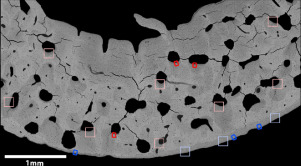当前位置:
X-MOL 学术
›
Acta Biomater.
›
论文详情
Our official English website, www.x-mol.net, welcomes your
feedback! (Note: you will need to create a separate account there.)
Newly formed and remodeled human bone exhibits differences in the mineralization process.
Acta Biomaterialia ( IF 9.4 ) Pub Date : 2020-01-09 , DOI: 10.1016/j.actbio.2020.01.004 Andreas Roschger 1 , Wolfgang Wagermaier 2 , Sonja Gamsjaeger 3 , Norbert Hassler 3 , Ingo Schmidt 2 , Stéphane Blouin 3 , Andrea Berzlanovich 4 , Gerlinde M Gruber 5 , Richard Weinkamer 2 , Paul Roschger 3 , Eleftherios P Paschalis 3 , Klaus Klaushofer 3 , Peter Fratzl 2
Acta Biomaterialia ( IF 9.4 ) Pub Date : 2020-01-09 , DOI: 10.1016/j.actbio.2020.01.004 Andreas Roschger 1 , Wolfgang Wagermaier 2 , Sonja Gamsjaeger 3 , Norbert Hassler 3 , Ingo Schmidt 2 , Stéphane Blouin 3 , Andrea Berzlanovich 4 , Gerlinde M Gruber 5 , Richard Weinkamer 2 , Paul Roschger 3 , Eleftherios P Paschalis 3 , Klaus Klaushofer 3 , Peter Fratzl 2
Affiliation

|
During human skeletal growth, bone is formed via different processes. Two of them are: new bone formation by depositing bone at the periosteal (outer) surface and bone remodeling corresponding to a local renewal of tissue. Since in remodeling formation is preceded by resorption, we hypothesize that modeling and remodeling could require radically different transport paths for ionic precursors of mineralization. While remodeling may recycle locally resorbed mineral, modeling implies the transport over large distances to the site of bone apposition. Therefore, we searched for potential differences of size, arrangement and chemical composition of mineral particles just below surfaces of modeling and remodeling sites in femur midshaft cross-sections from healthy children. These bone sites were mapped using scanning synchrotron X-ray scattering, Raman microspectroscopy, energy dispersive X-ray analysis and quantitative backscattered electron microscopy. The results show clear differences in mineral particle size and composition between the sites, which cannot be explained by a change in the rate of mineral apposition or accumulation. At periosteal modeling sites, mineral crystals are distinctly larger, display higher crystallinity and exhibit a lower calcium to phosphorus ratio and elevated Na and Mg content. The latter may originate from Mg used for phase stabilization of mineral precursors and therefore indicate different time periods for mineral transport. We conclude that the mineralization process is distinctively different between modeling and remodeling sites due to varying requirements for the transport distance and, therefore, the stability of non-crystalline ionic precursors, resulting in distinct compositions of the deposited mineral phase. STATEMENT OF SIGNIFICANCE: In growing children new bone is formed either due to apposition of bone tissue e.g. at the outer ridge of long bones to allow growth in thickness (bone modeling), or in cavities inside the mineralized matrix when replacing tissue (bone remodeling). We demonstrate that mineral crystal shape and composition are not the same between these two sites, which is indicative of differences in mineralization precursors. We suggest that this may be due to a longer mineral transport distance to sites of new bone formation as compared to remodeling where mineral can be locally recycled.
中文翻译:

刚形成和重塑的人体骨骼在矿化过程中表现出差异。
在人体骨骼生长过程中,骨骼是通过不同的过程形成的。其中两个是:通过在骨膜(外)表面沉积骨骼形成新的骨骼,以及与组织局部更新相对应的骨骼重塑。由于在重塑过程中形成是在吸收作用之前进行的,因此我们假设进行建模和重塑可能要求矿化的离子前驱体具有根本不同的传输路径。虽然重塑可能会回收局部吸收的矿物质,但重塑意味着要在很长的距离内运输到骨骼附着部位。因此,我们在健康儿童的股骨中轴横断面建模和重塑部位的表面下方搜索了矿物颗粒的大小,排列和化学成分的潜在差异。使用扫描同步加速器X射线散射绘制这些骨骼部位的图,拉曼光谱,能量色散X射线分析和定量反向散射电子显微镜。结果表明两个位置之间的矿物粒度和组成存在明显差异,这不能用矿物沉积或堆积速率的变化来解释。在骨膜建模部位,矿物晶体明显更大,显示出更高的结晶度,并显示出较低的钙磷比率以及升高的Na和Mg含量。后者可能源自用于矿物前驱物相稳定的Mg,因此指示了矿物运输的不同时间段。我们得出的结论是,由于对运输距离的要求不同,因此,非结晶离子前体的稳定性不同,因此,建模和重塑位置之间的矿化过程明显不同。导致沉积矿相的组成不同。意义说明:在成长中的儿童中,由于骨骼组织的并置(例如在长骨的外脊处允许厚度增长)而形成了新的骨骼(骨骼塑形),或者在替换组织时在矿化基质内部的空腔中形成了新骨骼(骨骼塑形) 。我们证明这两个位置之间的矿物晶体形状和组成不相同,这表明矿化前体存在差异。我们建议,这可能是由于相比于可以局部回收矿物质的重塑,矿物质到新骨形成部位的运输距离更长。在长骨的外脊处增加厚度(骨骼塑形),或者在替换组织时在矿化基质内部的空腔中生长(骨骼塑形)。我们证明这两个位置之间的矿物晶体形状和组成不相同,这表明矿化前体存在差异。我们建议,这可能是由于相比于可以局部回收矿物质的重塑,矿物质到新骨形成部位的运输距离更长。在长骨的外脊处增加厚度(骨骼塑形),或者在替换组织时在矿化基质内部的空腔中生长(骨骼塑形)。我们证明这两个位置之间的矿物晶体形状和组成不相同,这表明矿化前体存在差异。我们建议,这可能是由于与重塑可以本地回收矿物质的重塑相比,矿物质到新骨形成部位的运输距离更长。
更新日期:2020-01-09
中文翻译:

刚形成和重塑的人体骨骼在矿化过程中表现出差异。
在人体骨骼生长过程中,骨骼是通过不同的过程形成的。其中两个是:通过在骨膜(外)表面沉积骨骼形成新的骨骼,以及与组织局部更新相对应的骨骼重塑。由于在重塑过程中形成是在吸收作用之前进行的,因此我们假设进行建模和重塑可能要求矿化的离子前驱体具有根本不同的传输路径。虽然重塑可能会回收局部吸收的矿物质,但重塑意味着要在很长的距离内运输到骨骼附着部位。因此,我们在健康儿童的股骨中轴横断面建模和重塑部位的表面下方搜索了矿物颗粒的大小,排列和化学成分的潜在差异。使用扫描同步加速器X射线散射绘制这些骨骼部位的图,拉曼光谱,能量色散X射线分析和定量反向散射电子显微镜。结果表明两个位置之间的矿物粒度和组成存在明显差异,这不能用矿物沉积或堆积速率的变化来解释。在骨膜建模部位,矿物晶体明显更大,显示出更高的结晶度,并显示出较低的钙磷比率以及升高的Na和Mg含量。后者可能源自用于矿物前驱物相稳定的Mg,因此指示了矿物运输的不同时间段。我们得出的结论是,由于对运输距离的要求不同,因此,非结晶离子前体的稳定性不同,因此,建模和重塑位置之间的矿化过程明显不同。导致沉积矿相的组成不同。意义说明:在成长中的儿童中,由于骨骼组织的并置(例如在长骨的外脊处允许厚度增长)而形成了新的骨骼(骨骼塑形),或者在替换组织时在矿化基质内部的空腔中形成了新骨骼(骨骼塑形) 。我们证明这两个位置之间的矿物晶体形状和组成不相同,这表明矿化前体存在差异。我们建议,这可能是由于相比于可以局部回收矿物质的重塑,矿物质到新骨形成部位的运输距离更长。在长骨的外脊处增加厚度(骨骼塑形),或者在替换组织时在矿化基质内部的空腔中生长(骨骼塑形)。我们证明这两个位置之间的矿物晶体形状和组成不相同,这表明矿化前体存在差异。我们建议,这可能是由于相比于可以局部回收矿物质的重塑,矿物质到新骨形成部位的运输距离更长。在长骨的外脊处增加厚度(骨骼塑形),或者在替换组织时在矿化基质内部的空腔中生长(骨骼塑形)。我们证明这两个位置之间的矿物晶体形状和组成不相同,这表明矿化前体存在差异。我们建议,这可能是由于与重塑可以本地回收矿物质的重塑相比,矿物质到新骨形成部位的运输距离更长。











































 京公网安备 11010802027423号
京公网安备 11010802027423号